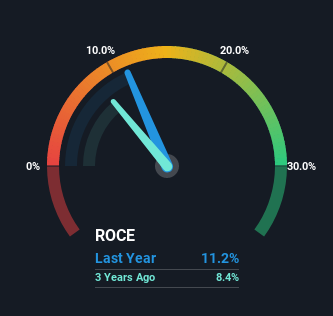- Spain
- /
- Electric Utilities
- /
- BME:ELE
Endesa (BME:ELE) Shareholders Will Want The ROCE Trajectory To Continue

If you're not sure where to start when looking for the next multi-bagger, there are a few key trends you should keep an eye out for. In a perfect world, we'd like to see a company investing more capital into its business and ideally the returns earned from that capital are also increasing. If you see this, it typically means it's a company with a great business model and plenty of profitable reinvestment opportunities. So when we looked at Endesa (BME:ELE) and its trend of ROCE, we really liked what we saw.
Understanding Return On Capital Employed (ROCE)
For those that aren't sure what ROCE is, it measures the amount of pre-tax profits a company can generate from the capital employed in its business. Analysts use this formula to calculate it for Endesa:
Return on Capital Employed = Earnings Before Interest and Tax (EBIT) ÷ (Total Assets - Current Liabilities)
0.11 = €3.3b ÷ (€50b - €21b) (Based on the trailing twelve months to December 2022).
So, Endesa has an ROCE of 11%. In absolute terms, that's a satisfactory return, but compared to the Electric Utilities industry average of 8.6% it's much better.
Check out our latest analysis for Endesa

Above you can see how the current ROCE for Endesa compares to its prior returns on capital, but there's only so much you can tell from the past. If you'd like, you can check out the forecasts from the analysts covering Endesa here for free.
The Trend Of ROCE
Investors would be pleased with what's happening at Endesa. Over the last five years, returns on capital employed have risen substantially to 11%. The amount of capital employed has increased too, by 25%. The increasing returns on a growing amount of capital is common amongst multi-baggers and that's why we're impressed.
On a side note, we noticed that the improvement in ROCE appears to be partly fueled by an increase in current liabilities. The current liabilities has increased to 41% of total assets, so the business is now more funded by the likes of its suppliers or short-term creditors. Given it's pretty high ratio, we'd remind investors that having current liabilities at those levels can bring about some risks in certain businesses.
The Key Takeaway
To sum it up, Endesa has proven it can reinvest in the business and generate higher returns on that capital employed, which is terrific. Investors may not be impressed by the favorable underlying trends yet because over the last five years the stock has only returned 37% to shareholders. So with that in mind, we think the stock deserves further research.
If you'd like to know more about Endesa, we've spotted 3 warning signs, and 2 of them are significant.
While Endesa isn't earning the highest return, check out this free list of companies that are earning high returns on equity with solid balance sheets.
Valuation is complex, but we're here to simplify it.
Discover if Endesa might be undervalued or overvalued with our detailed analysis, featuring fair value estimates, potential risks, dividends, insider trades, and its financial condition.
Access Free AnalysisHave feedback on this article? Concerned about the content? Get in touch with us directly. Alternatively, email editorial-team (at) simplywallst.com.
This article by Simply Wall St is general in nature. We provide commentary based on historical data and analyst forecasts only using an unbiased methodology and our articles are not intended to be financial advice. It does not constitute a recommendation to buy or sell any stock, and does not take account of your objectives, or your financial situation. We aim to bring you long-term focused analysis driven by fundamental data. Note that our analysis may not factor in the latest price-sensitive company announcements or qualitative material. Simply Wall St has no position in any stocks mentioned.
About BME:ELE
Endesa
Engages in the generation, distribution, and sale of electricity in Spain, Portugal, France, Germany, the United Kingdom, Switzerland, Luxembourg, the Netherlands, Singapore, Italy, Morocco, and internationally.
Outstanding track record established dividend payer.
Similar Companies
Market Insights
Community Narratives





